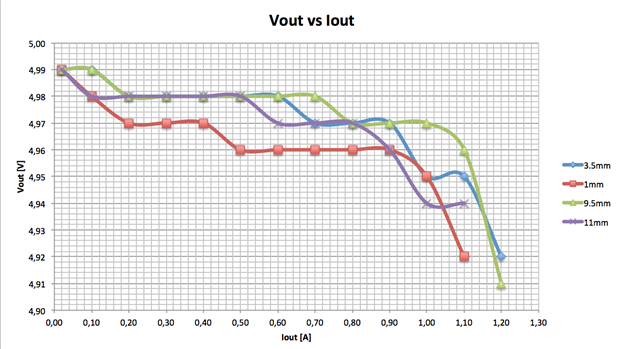This last week I have been busy doing some tests to the wireless power kit.
The first thing I wanted to measure was the efficiency. I decided to measure efficiency from 0 to 1.2 Amps of output current in steps o 100mA. Obviously efficiency is going to change with the distance between the coils, so I measured it with the following coil separations: 1, 3.5, 9.5 and 11mm. These strange numbers result from the combination of the following:
- 1mm: It’s the thickness of the plastic mount to which the receiver coil is attached. I wasn’t able to accurately measuring it, so I took Hendrik Lipkas word for it.
- 3.5mm: The receiver plastic mount + the acrylic base of 2.5mm
- 9.5mm: I 3d printed two small 5mm stand-offs for testing. Add 1 on top of the prior 3.5 mm and you get 9.5mm
- 11: Removed the transparent plate and used both stand-offs. 5+5+1 = 11 J
Equipment Setup and Test Conditions:
I connected the power transmitter to a regulated DC power supply at 5.0 V. Voltage was measured at the transmitter input pins, as voltage drop across the cable becomes significant with up to 2 Amps current. As the power supply also displays the delivered current, no additional equipment was needed on the transmitter side.
On the receivers side I connected my electronic load (see previous post) to Vout and Gnd (J3 and J2) of the receiver board. In parallel to that I connected a Voltmeter. This has to be done on the receiver pins for the same reason as with the transmitter. Another multimeter measured current flowing through the load. Finally, the electronic load was powered by another independent power supply (12V)
There are various user settings on the receiver that can influence its behavior:
- EN1 and EN2: These control the operation mode of the receiver, setting the priority of wireless or wired power, OTG mode etc (añadir más detalles).
In my tests, both are set to low
- Ilim: The receiver board has an overcurrent protection circuit build in. It allows us, by selecting the right value for a resistance, to set the max output current. In the EVM, we can either select a fixed 110Ohm resistor or a potentiometer through a jumper. I used the potentiometer in its minimum position, measuring 198 Ohm between JP6-ADJ and GND position in order to get as much current as possible out of the device.
- TS: The TS jumper allows us to enable the thermal shutdown function of the receiver. If a NTC resistor is connected on J5, this jumper allows us to enable the function and regulate the threshold temperature. In our case, the jumper was set to disable the function.
The test procedure was quite simple: Set the output current to the desired value, write down the values, increase current by 0.1A, write down the values, increase....
And here are the results:
<html><head><title>Jive SBS</title></head>
<body><font face="arial,helvetica,sans-serif">
<b>Error</b><br><font size="-1">
An general error occurred while processing your request.
</font></font></body></html>
These graphs show very clearly how the efficiency is affected by coil separation. They also resemble the ones found in the data sheets. I have attached the excel file if someone wants to take a closer look at the numbers.
The next thing on my testing list was to test different core materials. Although I did not expect them to influence the result (unless you use metal, in that case the Foreign object detection (FOD) should stop the transfer), I wanted to confirm it.
As core materials I chose medium density fiberboard (MDF) and a solid 3d-printed PLA sheet. Both were 3mm thick.
<html><head><title>Jive SBS</title></head>
<body><font face="arial,helvetica,sans-serif">
<b>Error</b><br><font size="-1">
An general error occurred while processing your request.
</font></font></body></html>
Looking at the results I don’t really think there is an influence at all. Sure, some points are not the same, but I rather think this is due to the difficulty of getting the exact same alignment in both test series.
Another interesting figure is Vout vs Iout. TI claims that the output voltage stays above 4.95V for a load current of up to 1.0 A. And it certainly does. Nevertheless it’s curious that voltage drops quicker with only 1mm distance. Maybe there was a little bit of lateral displacement while I took the measurements. But it doesn’t really matter.
For next week I want to take a closer look with the scope at the different signals present on the board: Communication, Rectified voltage, Modulation signals etc. Most of them are available on the datasheet, but it’s always nice to be able to reproduce them.


Top Comments
-

hlipka
-
Cancel
-
Vote Up
0
Vote Down
-
-
Sign in to reply
-
More
-
Cancel
Comment-

hlipka
-
Cancel
-
Vote Up
0
Vote Down
-
-
Sign in to reply
-
More
-
Cancel
Children